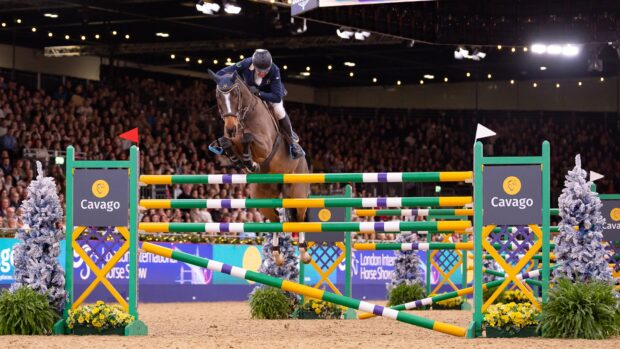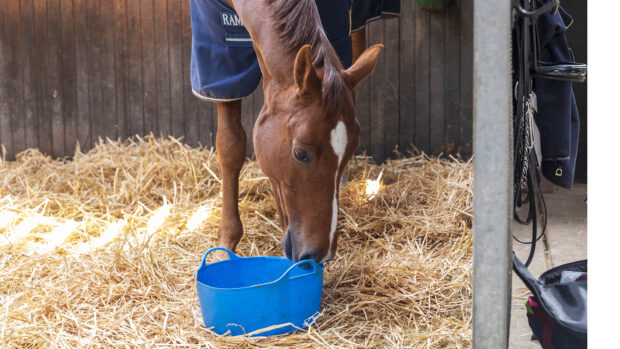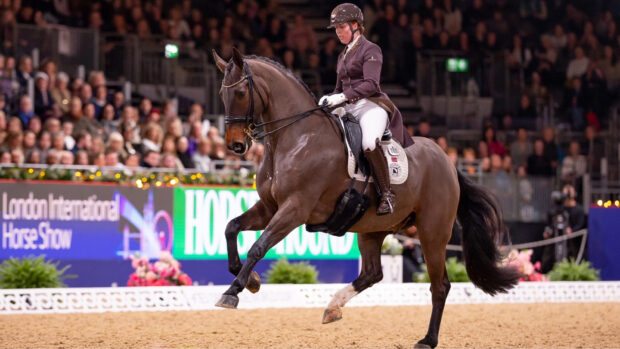Horses who have undergone neurectomies may be allowed to return to national dressage competition in certain circumstances under new British Dressage (BD) rules.
H&H reported last year that BD had published a clarification of its existing rules, giving specific mention to neurectomy and limb sensitivity. It confirmed to H&H at the time that “horses which have undergone neurectomy surgery at any time are not permitted to compete in BD competitions” (news, 24 February). BD has now changed its rules for 2023 following “feedback from vets”.
This is not a carte blanche. Instead, it is a protocol whereby horses who have had a surgical procedure impacting limb sensitivity could be eligible to return to competition, provided they meet strict criteria.
The 2023 BD rulebook states that a horse is not eligible to compete when a limb, or part of a limb, is hyposensitive or hypersensitive. It adds that hypersensitive limbs have an excessive or abnormal reaction to palpitation, and hyposensitive limbs include any alteration in sensitivity induced by a neurectomy or chemical desensitisation, for as long as the alternation in sensitivity persists.
“In order to continue participating in BD competition, horses that have previously had these surgical procedures on any limb must be re-examined and certified as fit to compete,” states the 2023 rule.
“The registered owner will need to provide a veterinary certificate, detailing the specific nature of the operation, with written confirmation from the vet that the horse has been passed fit to return to competition.
“The [BD] welfare panel will then review the evidence presented and determine whether the procedure contravenes BD rules and regulations on grounds of equine welfare.”
The rule adds that from 1 January, any horse who has a procedure on a limb, which “may put its welfare or the safety of other horses and/or athletes at risk” must have a minimum six months’ rehabilitation. After this, the owner must also provide veterinary confirmation that the horse is fit to compete, which will be reviewed by the welfare panel.
BD sport operations manager Lou Jones told H&H the changes were “in response to feedback from vets, to acknowledge that there are several different types of procedures, not all of which would be in breach of this rule”.
“The wording therefore has been amended, in consultation with our own veterinary experts on our welfare panel, to provide further clarification for members,” she said.
“By requesting veterinary certificates, we can deal with individual cases specifically around the procedure, judging each on a case-by-case basis.
“Equally, for those planning surgical procedures for their horses in the future, we now require a ‘fit to ride’ certificate from the vet to confirm that an appropriate period of rehabilitation has elapsed before a horse is allowed to compete again.
“However, it is important to stress that we still take the same stance on any surgical procedure that may impact negatively on a horse’s welfare and ability to compete.”
British Equine Veterinary Association veterinary projects officer Lucy Grieve told H&H the requirement for horses who have undergone these types of surgical procedures “seems a reasonable approach”.
“If a horse is deemed fit to compete by a veterinary surgeon, and the BD welfare board are satisfied by the information they receive, that should be sufficient to safeguard the horse’s welfare, as well as the safety of the rider and other competitors and horses,” she said.
“Checking skin sensation, ‘normal’ posturing and locomotion, and neurological status in my mind is as much as can be done to avoid the gross and avoidable welfare breaches which have been previously seen in horse sport.
“Examining horses who have undergone surgery on a limb, prior to being allowed to compete, would present an opportunity to safeguard horses’ welfare.
“Enforcing a six-month rehabilitation period would prevent horses being brought back into competition too soon, or before they have undergone sufficient training to determine if the limb has fully recovered.”
She added: “As always there will be potential for the system to be abused/deceived, but you would hope that this is difficult to do and the drive to protect horse’s welfare is sufficient in all competitors that they will welcome these changes.”
Rider Susan Saward told H&H it is a “welcome change” but said it has sadly come “too late” for many.
Ms Saward spoke to H&H in February 2022 to raise concerns about what the previous rule meant for the “bigger picture”, in terms of the future and welfare of other horses. She flagged that it did not encourage honesty and questioned how BD intended to police it. She also suggested that passports should be marked if horses have the procedure, so future owners are aware and can care for them appropriately.
“I think BD should have approached it in this way a year ago,” she said this week.
Ms Saward had opted for the procedure for her part-bred Lipizzaner Dolce, a decision she made in the best interests of the mare’s welfare. After 18 months of rehabilitation, Ms Saward said Dolce’s tension and unpredictability had gone, she was relaxed and “completely settled” and showing signs of “full feeling” in that leg. She said she has “never hidden” the fact Dolce had the procedure, fully believing it was BD-legal, and was “mortified” to discover otherwise.
“I wouldn’t compete her if she wasn’t happy, I would just retire her,” she said at the time.
A year on, the pair are enjoying sponsored rides and hacking with friends, and Dolce has a home for life with Ms Saward.
British Dressage rules: what else is new for 2023?
New para freestyle music championships to cater for all levels of competitors will be launched at Hartpury this summer.
The freestyle championships for all sections – bronze, silver and gold – will run alongside the para bronze and silver championships at the Equissage Pulse Summer Festival of Para Dressage (23 to 24 August).
To qualify, competitors need to gain one 63% or above score at a qualifier in their relevant section from 1 January to 30 June 2023.
Ms Jones told H&H that the championships have been introduced after developing new music tests for bronze and silver para riders.
“Previously only FEI Freestyle tests were used and therefore only available to Gold Para riders,” said she said.
“We wanted to increase the availability of music options for all para riders, making them accessible to those competing in the bronze and silver sections too.
“Now we have tests for all, we are able to introduce a para music championship.”
A number of new non-freestyle para tests are also being introduced this year in both national and international competition.
The FEI has renamed its tests and these now follow similar lines – although not exactly the same – as able-bodied tests. For example, the old “team test” is now known as “grand prix test A” and the old “individual test” is now known as “grand prix test B”. At the World Championships in Herning last year, the old names were confusing as the individual test counted for the team competition, while individual medals were decided on the team test.
Rider Di Fisher, who combines competing alongside her job as a major trauma consultant, welcomed the new championships and told H&H she will be targeting them this year.
“I’m really excited to get going this year and there’s so much more to choose from rather than just having a single test to ride,” she said.
“BD has really listened to feedback from its riders and is making a massive effort to make para dressage much more inclusive and attractive to all eligible riders.
“With freestyle, you can really play to your horses strengths and show your best friend off. Plus who doesn’t love riding to their favourite music?
“‘Winnie’ and I will definitely be taking part and will be working our hardest to be dancing down that centre line at the para freestyle and bronze championships at Hartpury this Summer.”
BD has also released new protocols designed to give competitors and venues clearer guidance on what to do when yellow, amber and red weather warnings are issued. These include when venues need to prepare a mitigation strategy, at what point the situation should be reviewed with BD, when competitions must be cancelled, and how much notice is ideally given to competitors.
The governing body has also brought introduced guidelines on maximum rider weight for 2023 as part of its code of conduct for equine welfare.
You might also be interested in:

Subscribe to Horse & Hound magazine today – and enjoy unlimited website access all year round

British Dressage’s neurectomy rule clarification sparks de-nerving debate

British Dressage brings in rider weight guidance for horse welfare
Horse & Hound magazine, out every Thursday, is packed with all the latest news and reports, as well as interviews, specials, nostalgia, vet and training advice. Find how you can enjoy the magazine delivered to your door every week, plus options to upgrade your subscription to access our online service that brings you breaking news and reports as well as other benefits.



